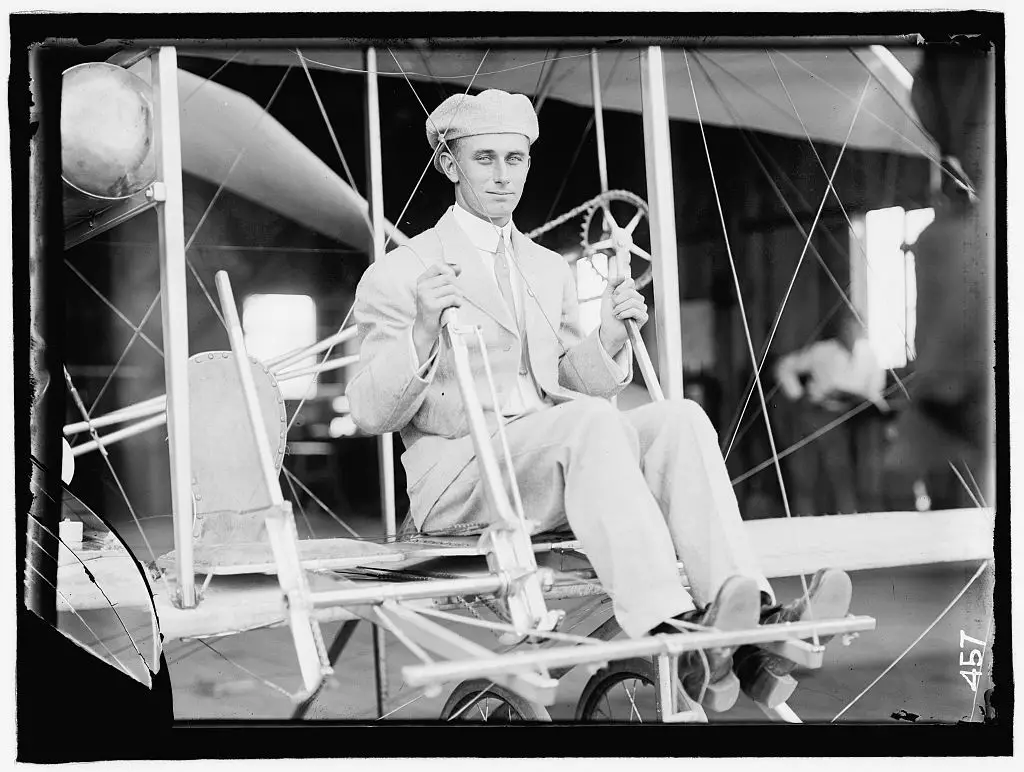Back in 2016, Rio de Janeiro hosted the Summer Olympics. The opening ceremony featured bossa nova, capoeira, and laser-lit choreography depicting key points in Brazil’s history. Among these theatric renditions was a curious biplane aviator that the Olympic announcer noted Brazilians claim to have beaten the Wright Brothers in their claim to fame. Are there any merits to this assertion? Has history snubbed this Brazilian inventor?

Alberto Santos-Dumont
Santos-Dumont was born on July 20, 1873 in Cabangu, a village within the municipality of Palmira, which was later renamed Santos Dumont after the hometown hero. He is best known for his No. 14-bis, as seen in the opening ceremony, though Santos-Dumont did not of course start with his greatest achievement. As the son of a Brazilian coffee magnate, Santos-Dumont was able to travel internationally. Going to the land of his fraternal grandparents, he studied under a private tutor in Paris to learn about the latest discoveries in engineering and machinery. A fan of Jules Vern since his youth, Santos-Dumont’s interest in what were then fantastical modes of transportation was rekindled and further stoked as hot air ballooning was a not uncommon pastime among wealthier Parisians.
His career as an aviation engineer began with simple balloons. These could be controlled along a vertical axis by adjusting the flame that heated the air inside the balloon. Hot air rises and so does a balloon filled with hot air. All further control over the balloon came down to wind and other weather factors. In 1898, Santos-Dumont made two balloons, the Brasil (the native spelling of his home country) and the America, the latter of which won a competition held by the Aero Club of Paris for staying aloft the longest.
Feeling accomplished though not yet satisfied, Santos-Dumont turned his attention to balloons that could be controlled under their own power. These steerable balloon, or dirigibles, occupied him for the next four years. He produced nine different dirigibles over that span, and the Santos Dumont no. 3 is likely the most famous given its public display of circling the Eiffel Tower on its preplanned route. With lighter-than-air craft solved, Santos-Dumont once again set his sights on a loftier engineering challenge: heavier-than-air craft.
While most of the Wright Brothers’ initial test flights were clandestine affairs, word of them travelled far and wide. Taking inspiration from reports of their Wright Flyer, Santos-Dumont shifted his focus to designing a biplane of his own.

No. 14-bis and the Wright Flyer
Santos-Dumont flew his No. 14-bis biplane before an audience on November 12, 1906. He soared about twenty feet (six meters) off the ground for a distance of approximately seven hundred and twenty-two feet (two hundred and twenty-two meters). Santos-Dumont’s inaugural heavier-than-air flight is certainly more impressive than Orville Wright’s initial twelve second flight, though it took place a whole three years prior. Given this, why do many Brazilians claim that Santos-Dumont ought to be regarded as the father of heavier-than-air aviation?
Depending on who you ask, there are two or three major arguments in favor of crediting Santos-Dumont over the Wright Brothers. Some argue that the Brazilian aviator’s first flight was done in full view of the public, whereas the Wright Flyer took off in secret, and thus its accomplishments are unverifiable. This first argument does not hold water when one looks into it. The Wright Brothers were secretive about their scientific advances, but they took meticulous contemporary notes of their progress, and many of their flights actually did have a few witnesses. Someone with a camera was there at Kitty Hawk to watch the Wright Flyer’s maiden voyage, which is how we have photographic evidence of the 1903 event.
Another critique against the Wright Brothers’ claim is that their biplane did not take off via its own power. The exact nature of this claim varies, but some allege that the Wright Flyer was only able to get off the ground because of a catapult like device, making it more of a controlled glider than a true aircraft. This critique also falls apart upon inspection. The 1903 Kitty Hawk flight did rely on a guide rail, but this device did not add propulsive power to the Wright Flyer’s takeoff.
The third common argument that favor’s Santos-Dumont’s claim to being first is that Kitty Hawk was especially windy and this was what kept the Wright Flyer in the air as opposed to the onboard engine. Specialists have argued over this, but most agree that the Wright Brothers’ biplane would not have stayed in the air as long as it did were it not propelling itself. Admittedly, twelve seconds of air time does not sound too dissimilar from gliding, but if this is a sticking point then one only need look to the Wright Flyer’s 1905 demonstration where it stayed aloft for forty minutes.

Santos-Dumont’s Legacy
Despite all this evidence why do some Brazilians still claim that Santos-Dumont was the first heavier-than-air aviator? Nationalist impulse is the likeliest cause. Heavier-than-air flight was a tremendous scientific stride. It makes sense that a nation would want to lay claim to this achievement through one of its own. This is not so different than both the United States and the former USSR claiming victories in the space race by coming up with different goalposts and criteria.
When Santos-Dumont returned to his home country in 1928 he was hailed as a hero. The inventions of him and his peers had been accepted by society as a step forward in various industries, though there was one in particular that Santos-Dumont had not accounted for. While planes were great for transportation, surveying, and making deliveries, they were also quickly adopted as another tool of war. Unable to cope with his addition to what he considered senseless violence, Santos-Dumont took his own life on July 23, 1932.
The legacies of history’s movers and shakers are often complex. Whether or not inventors and scientists are exempt from the use or misuse of their creations is a topic deserving of its own treatment. Science, as with most other fields, is a group effort that is only able to move forward thanks to the contributions from giants of the past. Santos-Dumont was an advocate of air travel, and showed crowds its utilitarian applications. His demonstrations helped change the public perception of heavier-than-air flight from being a rich hobbyist’s pastime to that of a viable method of transportation. While those in aeronautics may not remember his name, they stand on the shoulders of Alberto Santos-Dumont.
Works Cited
“Brazil Takes Pride in Spectacular Rio 2016 Opening”. International Olympic Committee, olympic.org, Aug 5 2016, http://www.olympic.org/news/brazil-takes-pride-in-spectacular-rio-2016-opening, Accessed Nov 10, 2020
Crouch, Tom D. “Alberto Santos-Dumont”. Encyclopedia Britannica, Britannica, http://www.britannica.com/biography/Alberto-Santos-Dumont, Accessed Nov 10, 2020
“Highlights in Aviation – Alberto Santos-Dumont”. Smithsonian Education, http://www.smithsonianeducation.org/scitech/impacto/graphic/aviation/alberto.html, Accessed Nov 10, 2020
Klein, Christopher. “History Faceoff: Who Was First In Flight?”. History, history.com, Dec 13, 2016, http://www.history.com/news/history-faceoff-who-was-first-in-flight, Accessed Nov 10, 2020
“Was the airplane’s inventor Brazilian?”. Reuters, cnn.com, Dec 10, 2003, http://www.cnn.com/2003/TECH/ptech/12/10/brazil.santosdumont.reut/, Accessed Nov 10, 2020

Click and check out these popular articles for more information: 🙂
Ectoderm vs Endoderm vs Mesoderm
Circulatory System: Blood Flow Pathway Through the Heart
Circulatory System: Heart Structures and Functions
Ductus Arteriosus Vs Ductus Venosus Vs Foramen Ovale: Fetal Heart Circulation
Cardiac Arrhythmias: Definition, Types, Symptoms, and Prevention
Upper Vs Lower Respiratory System: Upper vs Lower Respiratory Tract Infections
Seven General Functions of the Respiratory System
Digestive System Anatomy: Diagram, Organs, Structures, and Functions
Kidney Embryology & Development: Easy Lesson
Psychology 101: Crowd Psychology and The Theory of Gustave Le Bon
Introduction to Evolution: Charles Darwin and Alfred Russel Wallace
Copyright © 2022 Moosmosis Organization: All Rights Reserved
All rights reserved. This essay or any portion thereof may not be reproduced or used in any manner whatsoever
without the express written permission of the publisher.
Categories: education, environment, History, Literature, Social Studies, travel















amazing article on aviation!
LikeLike
Very fascinating read and informative! Learned something new about aviation. Cheers!
LikeLiked by 1 person
Great article!
LikeLiked by 1 person